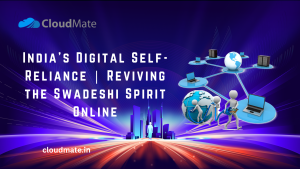
Bridging Tradition and Technology
The Swadeshi movement of the early 20th century encouraged Indians to support local industries and reduce dependence on foreign goods. It wasnt just an economic decision; it was an act of self-respect and national pride.
Today, that same idea is being reimagined in the digital world. As India becomes one of the fastest-growing digital economies, the need for technological independence has never been greater. Prime Minister Narendra Modis vision of Aatmanirbhar Bharat calls for building solutions that are made in India, hosted in India, and managed by Indian expertise.
This new wave often called the Digital Self-Reliance Movement, focuses on controlling Indias digital assets, from cloud servers to data storage systems. Its about ensuring that the digital backbone of the nation is as Indian as the spirit that drives it.
In this article, we will see how plarform like Cloudmate contribute in Digital Self Reliance movement.
The Digital Meaning of Swadeshi
In the past, Swadeshi was about manufacturing local textiles and goods. Today, its about hosting our websites, apps, and business data on Indian servers. The idea remains the same: rely on local resources, strengthen national capabilities, and promote innovation from within.
When our data is hosted abroad, its often subject to foreign laws and privacy standards. This exposes businesses to risks related to security, compliance, and even control over their information. The more we depend on foreign technology, the less control we have over our own data.
Thats why the Digital Swadeshi Movement isnt just symbolic – its a practical shift toward sovereignty in the modern era. Its about taking back control of what truly matters in todays world: data, privacy, and trust.
A Movement of Digital Independence
Digital Swadeshi isn’t limited to large corporations or the government. Its being driven from the ground up by startups, small businesses, developers, and everyday internet users who choose Indian platforms and hosting providers.
For example, Indian companies are now creating alternatives to global tech giants – whether its in cloud computing, fintech, digital payments, or e-commerce. Platforms like UPI and DigiLocker are clear examples of how India is building digital tools by and for Indians.
By choosing local solutions, we encourage innovation, create jobs, and build digital infrastructure that reflects our values and protects our citizens. This collective effort ensures that India stays in control of its digital destiny.
From Physical Goods to Digital Infrastructure
In the early 1900s, Swadeshi meant using Indian textiles instead of British cloth. In 2025, it means using Indian servers instead of foreign ones. The principle is unchanged; support whats local, secure, and beneficial to the nations growth.
Just as Indian industries once built factories and local supply chains, todays digital Swadeshi movement focuses on creating data centers, cloud platforms, and hosting solutions based in India. These infrastructures are the backbone of modern communication, e-commerce, and digital innovation.
When businesses choose to host their data in India, they do more than comply with local regulations. They actively contribute to the nations growth. Every rupee spent on Indian hosting, software, and cloud services fuels domestic innovation, generates skilled employment, and reduces foreign dependency.
Why This Movement Matters Now
Indias digital presence is expanding rapidly with millions of new users joining the internet each month. This growth has created a massive amount of data that must be stored, managed, and protected responsibly.
If this data remains scattered across global servers, India risks losing control over its most valuable resource i.e., information. Thats why the government and private players alike are emphasizing data localization and digital self-reliance.
Digital Swadeshi, therefore, isnt just a technological movement – its an economic and strategic one. Its about protecting national interests while empowering Indian businesses to compete globally with homegrown solutions.
The Road Ahead
The future of Indias digital economy depends on how effectively we can balance innovation with independence. As we move deeper into the data-driven era, every click, transaction, and communication becomes part of the nations digital identity.
By embracing the Digital Swadeshi philosophy, India can ensure that this identity remains secure, self-reliant, and rooted in national values. Whether its through Indian hosting companies like Cloudmate, indigenous apps, or local software ecosystems, the goal is the same to build a digital India that stands tall on its own foundation.
Frequently Asked Questions (FAQs)
- What is the Digital Swadeshi Movement?
The Digital Swadeshi Movement is about promoting India-made and India-hosted digital solutions. It encourages businesses and individuals to rely on local technology, data centers, and software, reducing dependence on foreign platforms. - Why is hosting data in India important?
Hosting data in India ensures it is subject to Indian laws and privacy standards. This improves security, maintains compliance with local regulations, and protects sensitive business and personal information. - Who can participate in this movement?
Everyone from large corporations and government agencies to startups, small businesses, and individual developers can contribute by choosing Indian hosting services, developing software locally, or supporting homegrown tech initiatives. - How does it benefit Indian businesses?
Using local hosting and digital services supports the domestic tech ecosystem, creates jobs, and encourages innovation. Businesses also gain better control over their data and reduce risks associated with cross-border data storage. - Is moving to Indian servers expensive?
Costs vary depending on services and requirements, but many Indian cloud providers offer competitive pricing. The long-term benefits, including improved data security and regulatory compliance, often outweigh the initial investment. - How can I start adopting Digital Swadeshi practices?
Start by evaluating your current digital infrastructure, choosing Indian hosting providers, exploring Indian-made software tools, and ensuring your data is stored securely within the country.